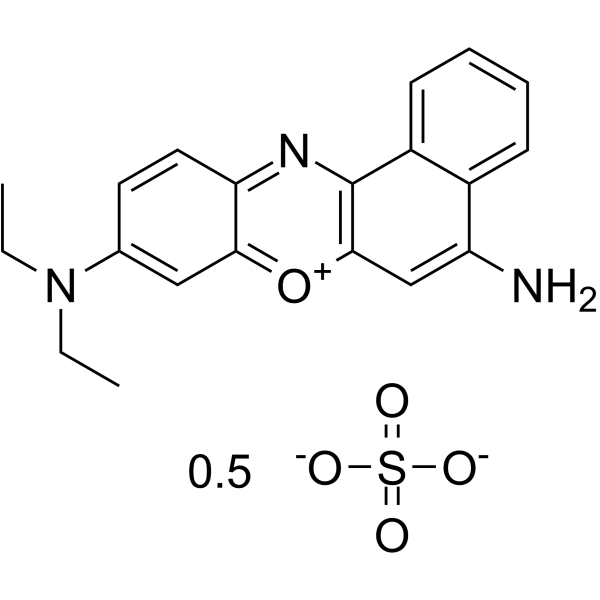Nile Blue A sulfate;(Synonyms: Nile blue sulfate) 纯度: ge;98.0%
Nile Blue A (Nile blue sulfate) 可用于区分黑色素和脂褐素。它也可用于脂肪染色,以及制备电流葡萄糖传感器。

Nile Blue A sulfate Chemical Structure
CAS No. : 3625-57-8
| 规格 | 价格 | 是否有货 | 数量 |
|---|---|---|---|
| Free Sample (0.1-0.5 mg) | ; | Apply now | ; |
| 10;mM;*;1 mL in DMSO | ¥550 | In-stock | |
| 100 mg | ¥500 | In-stock | |
| 200 mg | ; | 询价 | ; |
| 500 mg | ; | 询价 | ; |
* Please select Quantity before adding items.
Nile Blue A sulfate 相关产品
bull;相关化合物库:
- Bioactive Compound Library Plus
| 生物活性 |
Nile Blue A (Nile blue sulfate) is used to differentiate melanins and lipofuscins. It is also useful for staining fats and preparation of an amperometric glucose sensor[1]. |
||||||||||||||||
|---|---|---|---|---|---|---|---|---|---|---|---|---|---|---|---|---|---|
| 体外研究 (In Vitro) |
Nile blue A is a basic oxazine dye which is soluble in water and ethyl alcohol. Nile blue A is a satisfactory stain for PHB granules in bacteria and is in fact superior to Sudan black B for this purpose. Poly-p3-hydroxybutyrate granules exhibits a strong orange fluorescence when stained with Nile blue A. Nile blue A appears to stain many more PHB granules than Sudan black B does and is not as easily ished from the cell by decolorization procedures[1]. Nile blue A is used as a stain for polyhydroxyalkanoic acid-accumulating microorganisms or to detect polyhydroxyalkanoic acids in microorganisms. Escherichia coli cells that do not accumulate detectable polyhydroxyalkanoic acids can be stained with Nile blue A and that this staining is sufficient for identifying these cells in fluorescence-activated cell sorting (FACS) experiments. Nile blue A staining does not affect either surface display of peptides or specific labeling of these peptides by a second fluorescence. Staining E. coli for flow cytometry using Nile blue A is an easy-to-handle and low-cost alternative to other fluorescent dyes or the intracellular expression of, for example, green fluorescent protein[2]. Nile blue A is one of the most studied benzophenoxazine dyes, as a potent photosensitizer for photodynamic therapy. The dye when administered intravenously disperses throughout the body by circulating through blood and is taken up by most cells that emphasize its interaction with various biomolecule[3]. MCE has not independently confirmed the accuracy of these methods. They are for reference only. |
||||||||||||||||
| 分子量 |
366.42 |
||||||||||||||||
| Formula |
C20H20N3O5S– |
||||||||||||||||
| CAS 号 |
3625-57-8 |
||||||||||||||||
| 中文名称 |
硫酸耐尔蓝A;硫酸尼罗蓝 |
||||||||||||||||
| 运输条件 |
Room temperature in continental US; may vary elsewhere. |
||||||||||||||||
| 储存方式 |
4deg;C, sealed storage, away from moisture and light *In solvent : -80deg;C, 6 months; -20deg;C, 1 month (sealed storage, away from moisture and light) |
||||||||||||||||
| 溶解性数据 |
In Vitro:;
DMSO : ≥ 150 mg/mL (409.37 mM) H2O : < 0.1 mg/mL (ultrasonic;warming) (insoluble) * “≥” means soluble, but saturation unknown. 配制储备液
*
请根据产品在不同溶剂中的溶解度选择合适的溶剂配制储备液;一旦配成溶液,请分装保存,避免反复冻融造成的产品失效。 |
||||||||||||||||
| 参考文献 |
|
| Cell Assay [1][2][3] |
1% aqueous solution of Nile blue A is prepared and filtered before use. Mild heating may be necessary to fully dissolve the stain. Heat-fixed smears of bacterial cells are stained with the Nile blue A solution at 55°C for 10 min in a coplin staining jar. After being stained, the slides are washed with tap water to remove excess stain and with 8% aqueous acetic acid for 1 min. The stained smear is washed and blotted dry with bibulous paper, remoistened with tap water, and covered with a no. 1 glass cover slip. The preparation is examined with a Nikon Labphot microscope with an episcopic fluorescence attachment[1]. The PHA− strain Escherichia coli UT5600(DE3) is stained with Nile blue A. In an Erlenmeyer flask, 20 mL of Luria–Bertani (LB) broth is inoculated with one colony of UT5600(DE3) and incubated for 14 h at 37 °C and 200 rpm. Subsequently, 20 mL of LB broth containing Nile blue A in a final concentration of 0.5 μg/mL is inoculated with 200 μL of the 14-h culture and cultured to an optical density at 578 nm (OD578) of 0.6. As a control, 20 mL of LB broth (without Nile blue A) is inoculated with 200 μL of the 14-h culture and is also cultured to an optical density at OD578 of 0.6. Every 20 min, the OD578 is determined for both cultures to verify whether there is any influence of the dye on the growth of the bacteria[2]. Nile blue A stock solution is prepared using ethanol as the solvent. The concentration of NB is maintained at 5 μM for all the studies. The solutions are left for 1 h to achieve equilibrium before spectral measurements. The absorption spectra are recorded using Shimadzu Spectrophotometer (UV-1800) and the emission spectra are recorded using Jobin–Yvon Spectrofluorimeter. A 450 nm nano-LED is used as the light source and the fluorescence lifetime is collected at λem=672 nm[3]. MCE has not independently confirmed the accuracy of these methods. They are for reference only. |
|---|---|
| 参考文献 |
|
